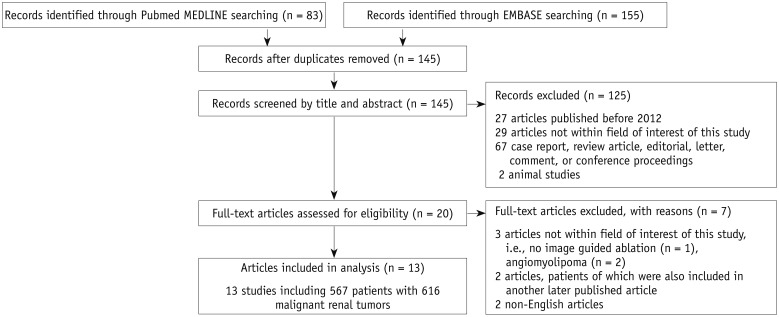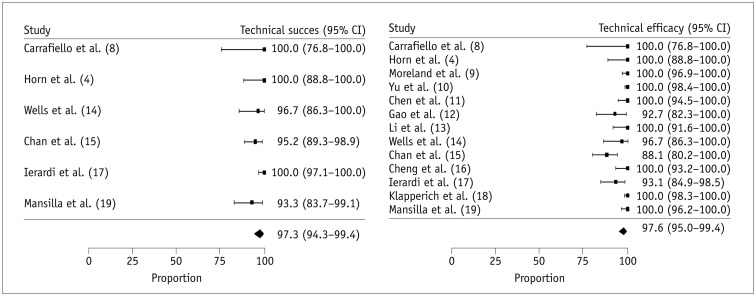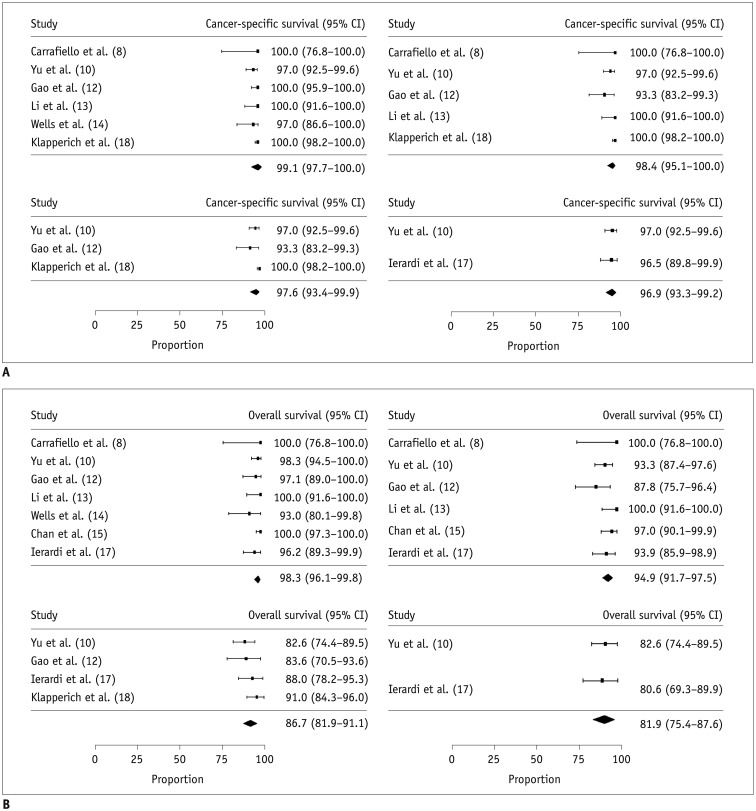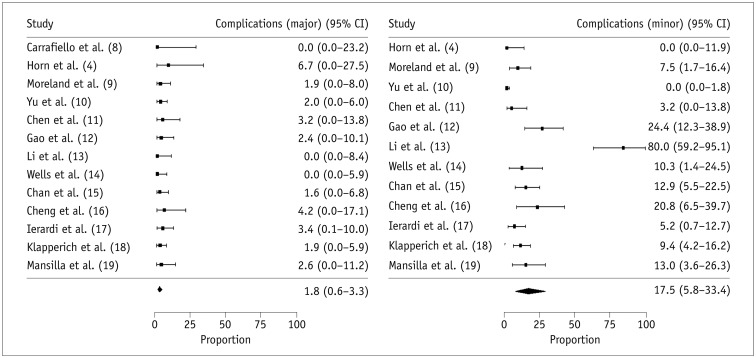Korean J Radiol.
2018 Oct;19(5):938-949. 10.3348/kjr.2018.19.5.938.
Efficacy and Safety of Microwave Ablation for Malignant Renal Tumors: An Updated Systematic Review and Meta-Analysis of the Literature Since 2012
- Affiliations
-
- 1Department of Radiology and Research Institute of Radiology, University of Ulsan College of Medicine, Asan Medical Center, Seoul 05505, Korea. m1fenew@daum.net
- KMID: 2418558
- DOI: http://doi.org/10.3348/kjr.2018.19.5.938
Abstract
OBJECTIVE
To systematically determine the treatment outcomes of percutaneous microwave ablation (MWA) in patients with malignant renal tumor.
MATERIALS AND METHODS
Original studies that reported the clinical outcomes of MWA in patients with malignant renal tumors were identified in MEDLINE and EMBASE from 2012 to June 30, 2017. Inverse variance and random-effects models were used to evaluate and acquire meta-analytic summary estimates of various clinical outcomes, including technical outcomes (technical success rate [TSR] and technical efficacy rate [TER]), oncologic outcomes (local tumor recurrence rate [LRR], cancer-specific survival rate [CSSR], and overall survival rate [OSR]), and complications.
RESULTS
Among the 145 articles screened, 13 articles including 567 patients carrying 616 malignant renal tumors were included in the meta-analysis. The meta-analytic pooled TSR and TER were 97.3% (95% confidence interval, 94.3-99.4%; I2 = 0.0%) and 97.6% (95.0-99.4%, I2 = 48.5%), respectively. The meta-analytic pooled LRR was 2.1% (0.3-4.7%, I2 = 54.1%). At 1-, 2-, 3-, and 5-year follow-up time points, the meta-analytic pooled CSSRs were 99.1% (97.2-100.0%; I2 = 0.0%), 98.4% (95.1-100.0%; I2 = 31.2%), 97.6% (93.4-99.9%; I2 = 52.3%), and 96.9% (93.3-99.2%; I2 = 0.0%) respectively, while the OSRs were 98.3% (96.1-99.8%; I2 = 0.0%), 94.9% (91.7-97.5%; I2 = 0.0%), 86.8% (81.9-91.1%; I2 = 22.1%), and 81.9% (75.4-87.6%; I2 = 0.0%). In terms of major complications, a 1.8% (0.6-3.3%; I2 = 0.0%) rate of meta-analytic pooled incidence was found.
CONCLUSION
Microwave ablation showed favorable technical and oncologic outcomes with a low incidence of major complications. Hence, image-guided percutaneous MWA can be considered as a safe and effective treatment for malignant renal tumors.
Keyword
MeSH Terms
Figure
Reference
-
1. Chow WH, Devesa SS, Warren JL, Fraumeni JF Jr. Rising incidence of renal cell cancer in the United States. JAMA. 1999; 281:1628–1631. PMID: 10235157.
Article2. Lucas SM, Stern JM, Adibi M, Zeltser IS, Cadeddu JA, Raj GV. Renal function outcomes in patients treated for renal masses smaller than 4 cm by ablative and extirpative techniques. J Urol. 2008; 179:75–79. discussion 79–80. PMID: 17997440.
Article3. Campbell SC, Novick AC, Belldegrun A, Blute ML, Chow GK, Derweesh IH, et al. Guideline for management of the clinical T1 renal mass. J Urol. 2009; 182:1271–1279. PMID: 19683266.
Article4. Horn JC, Patel RS, Kim E, Nowakowski FS, Lookstein RA, Fischman AM. Percutaneous microwave ablation of renal tumors using a gas-cooled 2.4-GHz probe: technique and initial results. J Vasc Interv Radiol. 2014; 25:448–453. PMID: 24581469.
Article5. Brace CL. Microwave tissue ablation: biophysics, technology, and applications. Crit Rev Biomed Eng. 2010; 38:65–78. PMID: 21175404.
Article6. Laeseke PF, Lee FT Jr, Sampson LA, van der Weide DW, Brace CL. Microwave ablation versus radiofrequency ablation in the kidney: high-power triaxial antennas create larger ablation zones than similarly sized internally cooled electrodes. J Vasc Interv Radiol. 2009; 20:1224–1229. PMID: 19616970.
Article7. Bartoletti R, Cai T, Tosoratti N, Amabile C, Crisci A, Tinacci G, et al. In vivo microwave-induced porcine kidney thermoablation: results and perspectives from a pilot study of a new probe. BJU Int. 2010; 106:1817–1821. PMID: 20346045.
Article8. Carrafiello G, Dionigi G, Ierardi AM, Petrillo M, Fontana F, Floridi C, et al. Efficacy, safety and effectiveness of image-guided percutaneous microwave ablation in cystic renal lesions Bosniak III or IV after 24 months follow up. Int J Surg. 2013; 11(Suppl 1):S30–S35. PMID: 24380547.
Article9. Moreland AJ, Ziemlewicz TJ, Best SL, Hinshaw JL, Lubner MG, Alexander ML, et al. High-powered microwave ablation of t1a renal cell carcinoma: safety and initial clinical evaluation. J Endourol. 2014; 28:1046–1052. PMID: 24846329.
Article10. Yu J, Zhang G, Liang P, Yu XL, Cheng ZG, Han ZY, et al. Midterm results of percutaneous microwave ablation under ultrasound guidance versus retroperitoneal laparoscopic radial nephrectomy for small renal cell carcinoma. Abdom Imaging. 2015; 40:3248–3256. PMID: 26288264.
Article11. Chen CN, Liang P, Yu J, Yu XL, Cheng ZG, Han ZY, et al. Contrast-enhanced ultrasound-guided percutaneous microwave ablation of renal cell carcinoma that is inconspicuous on conventional ultrasound. Int J Hyperthermia. 2016; 32:607–613. PMID: 27269816.
Article12. Gao Y, Liang P, Yu X, Yu J, Cheng Z, Han Z, et al. Microwave treatment of renal cell carcinoma adjacent to renal sinus. Eur J Radiol. 2016; 85:2083–2089. PMID: 27776662.
Article13. Li X, Yu J, Liang P, Yu X, Cheng Z, Han Z, et al. Combination therapy of three-dimensional (3D) visualisation operative treatment planning system and US-guided percutaneous microwave ablation in larger renal cell carcinomas (D ≥ 4 cm): preliminary results. Int J Hyperthermia. 2016; 1–7.14. Wells SA, Wheeler KM, Mithqal A, Patel MS, Brace CL, Schenkman NS. Percutaneous microwave ablation of T1a and T1b renal cell carcinoma: short-term efficacy and complications with emphasis on tumor complexity and single session treatment. Abdom Radiol (NY). 2016; 41:1203–1211. PMID: 27167230.
Article15. Chan P, Vélasco S, Vesselle G, Boucebci S, Herpe G, Debaene B, et al. Percutaneous microwave ablation of renal cancers under CT guidance: safety and efficacy with a 2-year follow-up. Clin Radiol. 2017; 72:786–792. PMID: 28545682.
Article16. Cheng Z, Yu X, Han Z, Liu F, Yu J, Liang P. Ultrasound-guided hydrodissection for assisting percutaneous microwave ablation of renal cell carcinomas adjacent to intestinal tracts: a preliminary clinical study. Int J Hyperthermia. 2017; 1–6.
Article17. Ierardi AM, Puliti A, Angileri SA, Petrillo M, Duka E, Floridi C, et al. Microwave ablation of malignant renal tumours: intermediate-term results and usefulness of RENAL and mRENAL scores for predicting outcomes and complications. Med Oncol. 2017; 34:97. PMID: 28421553.
Article18. Klapperich ME, Abel EJ, Ziemlewicz TJ, Best S, Lubner MG, Nakada SY, et al. Effect of tumor complexity and technique on efficacy and complications after percutaneous microwave ablation of stage T1a renal cell carcinoma: a single-center, retrospective study. Radiology. 2017; 284:272–280. PMID: 28076721.
Article19. Mansilla AV, Bivins EE Jr, Contreras F, Hernandez MA, Kohler N, Pepe JW. CT-guided microwave ablation of 45 renal tumors: analysis of procedure complexity utilizing a percutaneous renal ablation complexity scoring system. J Vasc Interv Radiol. 2017; 28:222–229. PMID: 27988263.
Article20. Katsanos K, Mailli L, Krokidis M, McGrath A, Sabharwal T, Adam A. Systematic review and meta-analysis of thermal ablation versus surgical nephrectomy for small renal tumours. Cardiovasc Intervent Radiol. 2014; 37:427–437. PMID: 24482030.
Article21. Martin J, Athreya S. Meta-analysis of cryoablation versus microwave ablation for small renal masses: is there a difference in outcome? Diagn Interv Radiol. 2013; 19:501–507. PMID: 24084196.
Article22. Stroup DF, Berlin JA, Morton SC, Olkin I, Williamson GD, Rennie D, et al. Meta-analysis of observational studies in epidemiology: a proposal for reporting. meta-analysis of observational studies in epidemiology (MOOSE) group. JAMA. 2000; 283:2008–2012. PMID: 10789670.23. Liberati A, Altman DG, Tetzlaff J, Mulrow C, Gøtzsche PC, Ioannidis JP, et al. The PRISMA statement for reporting systematic reviews and meta-analyses of studies that evaluate healthcare interventions: explanation and elaboration. BMJ. 2009; 339:b2700. PMID: 19622552.
Article24. Moher D, Liberati A, Tetzlaff J, Altman DG. PRISMA Group. Preferred reporting items for systematic reviews and meta-analyses: the PRISMA statement. BMJ. 2009; 339:b2535. PMID: 19622551.
Article25. Goldberg SN, Grassi CJ, Cardella JF, Charboneau JW, Dodd GD 3rd, Dupuy DE, et al. Image-guided tumor ablation: standardization of terminology and reporting criteria. Radiology. 2005; 235:728–739. PMID: 15845798.
Article26. Higgins JP, Thompson SG, Deeks JJ, Altman DG. Measuring inconsistency in meta-analyses. BMJ. 2003; 327:557–560. PMID: 12958120.
Article27. Lee J, Kim KW, Choi SH, Huh J, Park SH. Systematic review and meta-analysis of studies evaluating diagnostic test accuracy: a practical review for clinical researchers-part II. statistical methods of meta-analysis. Korean J Radiol. 2015; 16:1188–1196. PMID: 26576107.
Article28. Campbell C, Lubner MG, Hinshaw JL, Muñoz del Rio A, Brace CL. Contrast media-doped hydrodissection during thermal ablation: optimizing contrast media concentration for improved visibility on CT images. AJR Am J Roentgenol. 2012; 199:677–682. PMID: 22915411.
Article29. Tracy CR, Raman JD, Donnally C, Trimmer CK, Cadeddu JA. Durable oncologic outcomes after radiofrequency ablation: experience from treating 243 small renal masses over 7.5 years. Cancer. 2010; 116:3135–3142. PMID: 20564644.30. Lyrdal D, Andersson M, Hellström M, Sternal J, Lundstam S. Ultrasound-guided percutaneous radiofrequency ablation of small renal tumors: clinical results and radiological evolution during follow-up. Acta Radiol. 2010; 51:808–818. PMID: 20707665.
Article31. Zagoria RJ, Pettus JA, Rogers M, Werle DM, Childs D, Leyendecker JR. Long-term outcomes after percutaneous radiofrequency ablation for renal cell carcinoma. Urology. 2011; 77:1393–1397. PMID: 21492910.
Article32. Rodriguez R, Cizman Z, Hong K, Koliatsos A, Georgiades C. Prospective analysis of the safety and efficacy of percutaneous cryoablation for pT1NxMx biopsy-proven renal cell carcinoma. Cardiovasc Intervent Radiol. 2011; 34:573–578. PMID: 20628879.
Article33. Kunkle DA, Uzzo RG. Cryoablation or radiofrequency ablation of the small renal mass: a meta-analysis. Cancer. 2008; 113:2671–2680. PMID: 18816624.34. Chalasani V, Martinez CH, Lim D, Abdelhady M, Chin JL. Surgical cryoablation as an option for small renal masses in patients who are not ideal partial nephrectomy candidates: intermediate-term outcomes. Can Urol Assoc J. 2010; 4:399–402. PMID: 21191499.
Article35. Carrafiello G, Laganà D, Mangini M, Fontana F, Dionigi G, Boni L, et al. Microwave tumors ablation: principles, clinical applications and review of preliminary experiences. Int J Surg. 2008; 6(Suppl 1):S65–S69. PMID: 19186116.
Article36. El Dib R, Touma NJ, Kapoor A. Cryoablation vs radiofrequency ablation for the treatment of renal cell carcinoma: a meta-analysis of case series studies. BJU Int. 2012; 110:510–516. PMID: 22304329.
Article37. Ahrar K, Matin S, Wood CG, Wallace MJ, Gupta S, Madoff DC, et al. Percutaneous radiofrequency ablation of renal tumors: technique, complications, and outcomes. J Vasc Interv Radiol. 2005; 16:679–688. PMID: 15872323.
Article38. Wah TM, Irving HC, Gregory W, Cartledge J, Joyce AD, Selby PJ. Radiofrequency ablation (RFA) of renal cell carcinoma (RCC): experience in 200 tumours. BJU Int. 2014; 113:416–428. PMID: 24053769.
Article39. McDougal WS, Gervais DA, McGovern FJ, Mueller PR. Long-term followup of patients with renal cell carcinoma treated with radio frequency ablation with curative intent. J Urol. 2005; 174:61–63. PMID: 15947578.
Article40. Weizer AZ, Raj GV, O'Connell M, Robertson CN, Nelson RC, Polascik TJ. Complications after percutaneous radiofrequency ablation of renal tumors. Urology. 2005; 66:1176–1180. PMID: 16360436.
Article41. Remzi M, Javadli E, Ozsoy M. Management of small renal masses: a review. World J Urol. 2010; 28:275–281. PMID: 20177900.
Article42. Okhunov Z, Shapiro EY, Moreira DM, Lipsky MJ, Hillelsohn J, Badani K, et al. R.E.N.A.L. nephrometry score accurately predicts complications following laparoscopic renal cryoablation. J Urol. 2012; 188:1796–1800. PMID: 22999696.
Article43. Kim EH, Tanagho YS, Bhayani SB, Saad NE, Benway BM, Figenshau RS. Percutaneous cryoablation of renal masses: Washington University experience of treating 129 tumours. BJU Int. 2013; 111:872–879. PMID: 23145500.
Article44. Schmit GD, Schenck LA, Thompson RH, Boorjian SA, Kurup AN, Weisbrod AJ, et al. Predicting renal cryoablation complications: new risk score based on tumor size and location and patient history. Radiology. 2014; 272:903–910. PMID: 24814178.
Article45. Guan W, Bai J, Liu J, Wang S, Zhuang Q, Ye Z, et al. Microwave ablation versus partial nephrectomy for small renal tumors: intermediate-term results. J Surg Oncol. 2012; 106:316–321. PMID: 22488716.
Article46. Yu J, Liang P, Yu XL, Cheng ZG, Han ZY, Mu MJ, et al. US-guided percutaneous microwave ablation of renal cell carcinoma: intermediate-term results. Radiology. 2012; 263:900–908. PMID: 22495684.
Article47. Yu J, Liang P, Yu XL, Cheng ZG, Han ZY, Zhang X, et al. US-guided percutaneous microwave ablation versus open radical nephrectomy for small renal cell carcinoma: intermediate-term results. Radiology. 2014; 270:880–887. PMID: 24475805.
Article48. Li X, Liang P, Yu XL, Yu J, Cheng ZG, Han ZY, et al. Percutaneous microwave ablation for renal cell carcinoma: evaluation of therapeutic effect with contrast-enhanced ultrasound. J Interv Radiol (China). 2014; 23:688–692.49. Han ZY, Liang P, Yu XL, Cheng ZG, Liu FY, Yu J. Ultrasound-guided percutaneous microwave ablation of sporadic renal angiomyolipoma: preliminary results. Acta Radiol. 2015; 56:56–62. PMID: 24526757.
Article50. Cristescu M, Abel EJ, Wells S, Ziemlewicz TJ, Hedican SP, Lubner MG, et al. Percutaneous microwave ablation of renal angiomyolipomas. Cardiovasc Intervent Radiol. 2016; 39:433–440. PMID: 26390876.
Article51. Mu MJ, Yu J, Liang P, Yu XL, Han ZY, Cheng ZG, et al. [Long-term effects of ultrasound-guided microwave ablation in the treatment of small renal cell carcinoma]. Nan Fang Yi Ke Da Xue Xue Bao. 2016; 36:622–627. PMID: 27222174.
- Full Text Links
- Actions
-
Cited
- CITED
-
- Close
- Share
- Similar articles
-
- Comparison of Thermal Ablation and Surgery for Low-Risk Papillary Thyroid Microcarcinoma: A Systematic Review and Meta-Analysis
- Systematic Review and Meta-analysis in Digestive Cancer Research
- Clinical guidelines for ovarian cancer: the Korean Society of Gynecologic Oncology guidelines
- Comparative Efficacy and Safety of Radiofrequency Ablation and Microwave Ablation in the Treatment of Benign Thyroid Nodules: A Systematic Review and Meta-Analysis
- Endometrial ablation and resection versus hysterectomy for heavy menstrual bleeding: an updated systematic review and meta-analysis of effectiveness and complications





